Economics Assignment - Managerial Economics, Dubai 2019
VerifiedAdded on 2022/10/17
|18
|1939
|4
Homework Assignment
AI Summary
This economics assignment delves into several key concepts, including market failure, price discrimination, and monopoly. The assignment begins by defining market failure and exploring government tools to correct it, such as taxation, subsidies, regulations, and pollution permits, with a specific example of a steel plant polluting a river. The second part analyzes supply and demand dynamics in the potato market, determining equilibrium price, quantity, consumer surplus, and producer surplus. The assignment then examines the effects of a tax on cigarettes on the market for substitutes like cigars and chewing tobacco. The concept of price discrimination is discussed, focusing on how it affects consumer surplus. Finally, the assignment explores market disruptions due to supply or demand-side interruptions, using the example of gasoline shortages caused by OPEC decisions or government price controls. Section B analyzes monopoly, calculating profit-maximizing output for a bookstore and illustrating the concepts graphically. The assignment concludes by discussing the competitive firm in the long run and how market conditions affect profitability, including the impact of license fees.
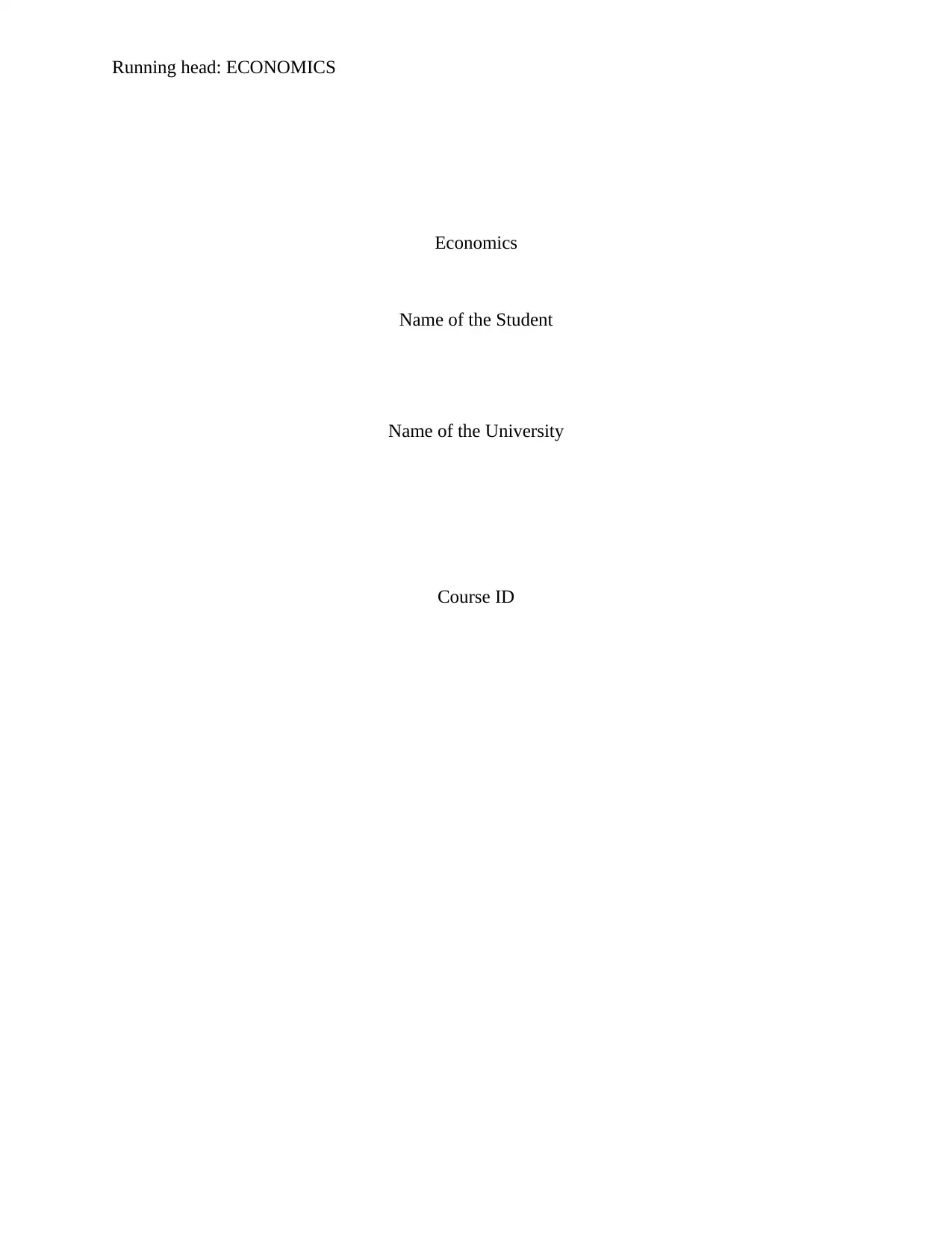
Running head: ECONOMICS
Economics
Name of the Student
Name of the University
Course ID
Economics
Name of the Student
Name of the University
Course ID
Paraphrase This Document
Need a fresh take? Get an instant paraphrase of this document with our AI Paraphraser
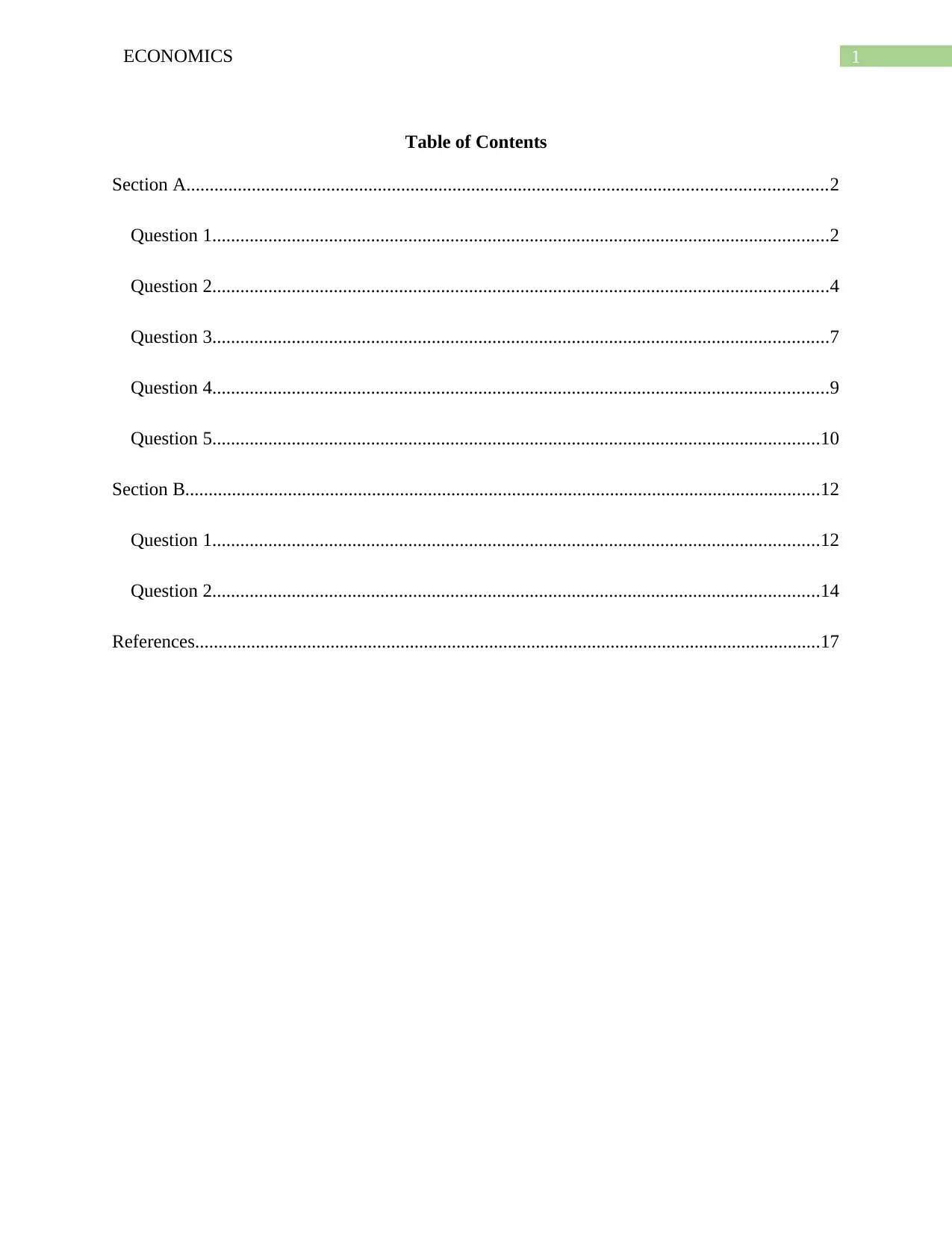
1ECONOMICS
Table of Contents
Section A.........................................................................................................................................2
Question 1....................................................................................................................................2
Question 2....................................................................................................................................4
Question 3....................................................................................................................................7
Question 4....................................................................................................................................9
Question 5..................................................................................................................................10
Section B........................................................................................................................................12
Question 1..................................................................................................................................12
Question 2..................................................................................................................................14
References......................................................................................................................................17
Table of Contents
Section A.........................................................................................................................................2
Question 1....................................................................................................................................2
Question 2....................................................................................................................................4
Question 3....................................................................................................................................7
Question 4....................................................................................................................................9
Question 5..................................................................................................................................10
Section B........................................................................................................................................12
Question 1..................................................................................................................................12
Question 2..................................................................................................................................14
References......................................................................................................................................17
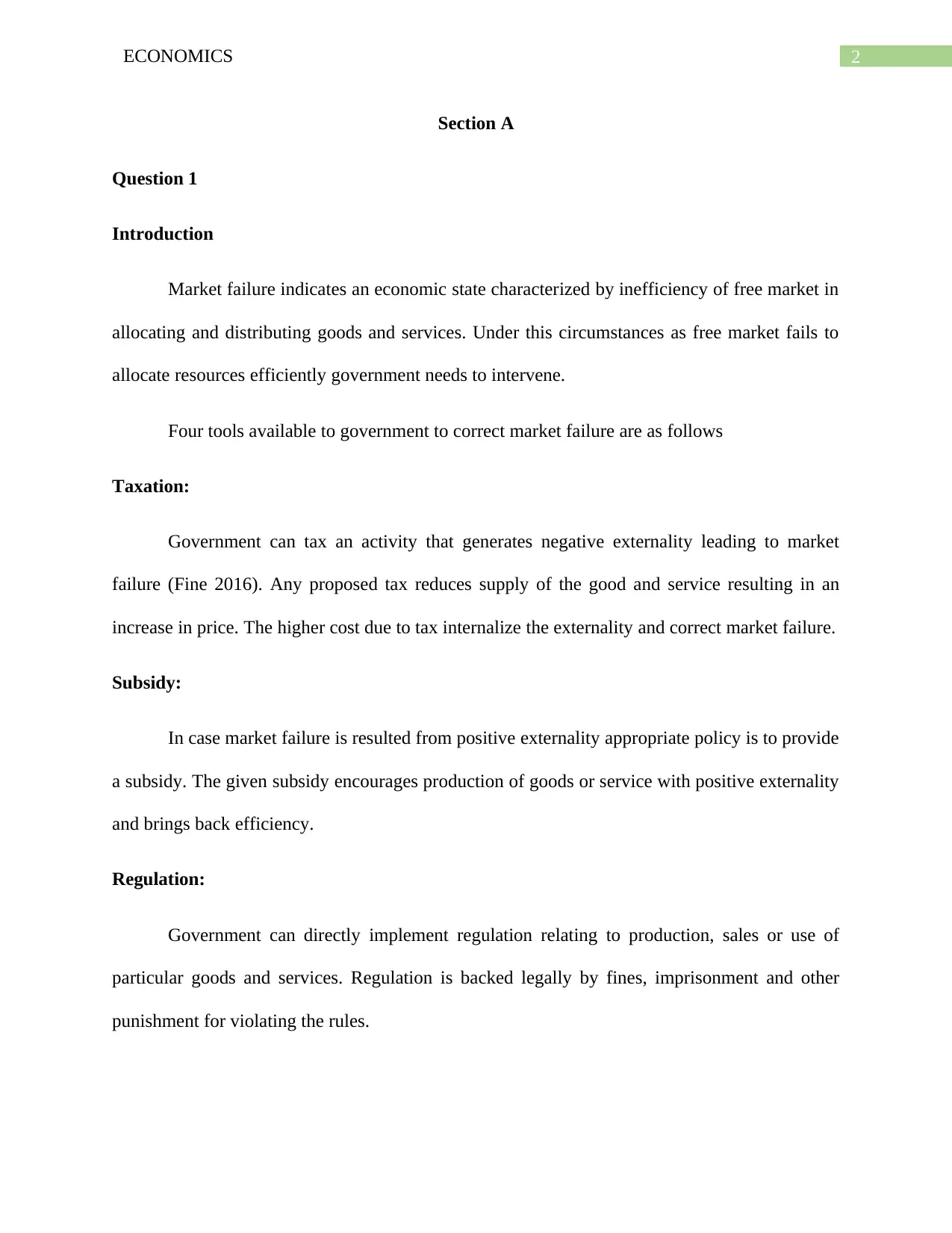
2ECONOMICS
Section A
Question 1
Introduction
Market failure indicates an economic state characterized by inefficiency of free market in
allocating and distributing goods and services. Under this circumstances as free market fails to
allocate resources efficiently government needs to intervene.
Four tools available to government to correct market failure are as follows
Taxation:
Government can tax an activity that generates negative externality leading to market
failure (Fine 2016). Any proposed tax reduces supply of the good and service resulting in an
increase in price. The higher cost due to tax internalize the externality and correct market failure.
Subsidy:
In case market failure is resulted from positive externality appropriate policy is to provide
a subsidy. The given subsidy encourages production of goods or service with positive externality
and brings back efficiency.
Regulation:
Government can directly implement regulation relating to production, sales or use of
particular goods and services. Regulation is backed legally by fines, imprisonment and other
punishment for violating the rules.
Section A
Question 1
Introduction
Market failure indicates an economic state characterized by inefficiency of free market in
allocating and distributing goods and services. Under this circumstances as free market fails to
allocate resources efficiently government needs to intervene.
Four tools available to government to correct market failure are as follows
Taxation:
Government can tax an activity that generates negative externality leading to market
failure (Fine 2016). Any proposed tax reduces supply of the good and service resulting in an
increase in price. The higher cost due to tax internalize the externality and correct market failure.
Subsidy:
In case market failure is resulted from positive externality appropriate policy is to provide
a subsidy. The given subsidy encourages production of goods or service with positive externality
and brings back efficiency.
Regulation:
Government can directly implement regulation relating to production, sales or use of
particular goods and services. Regulation is backed legally by fines, imprisonment and other
punishment for violating the rules.
⊘ This is a preview!⊘
Do you want full access?
Subscribe today to unlock all pages.

Trusted by 1+ million students worldwide
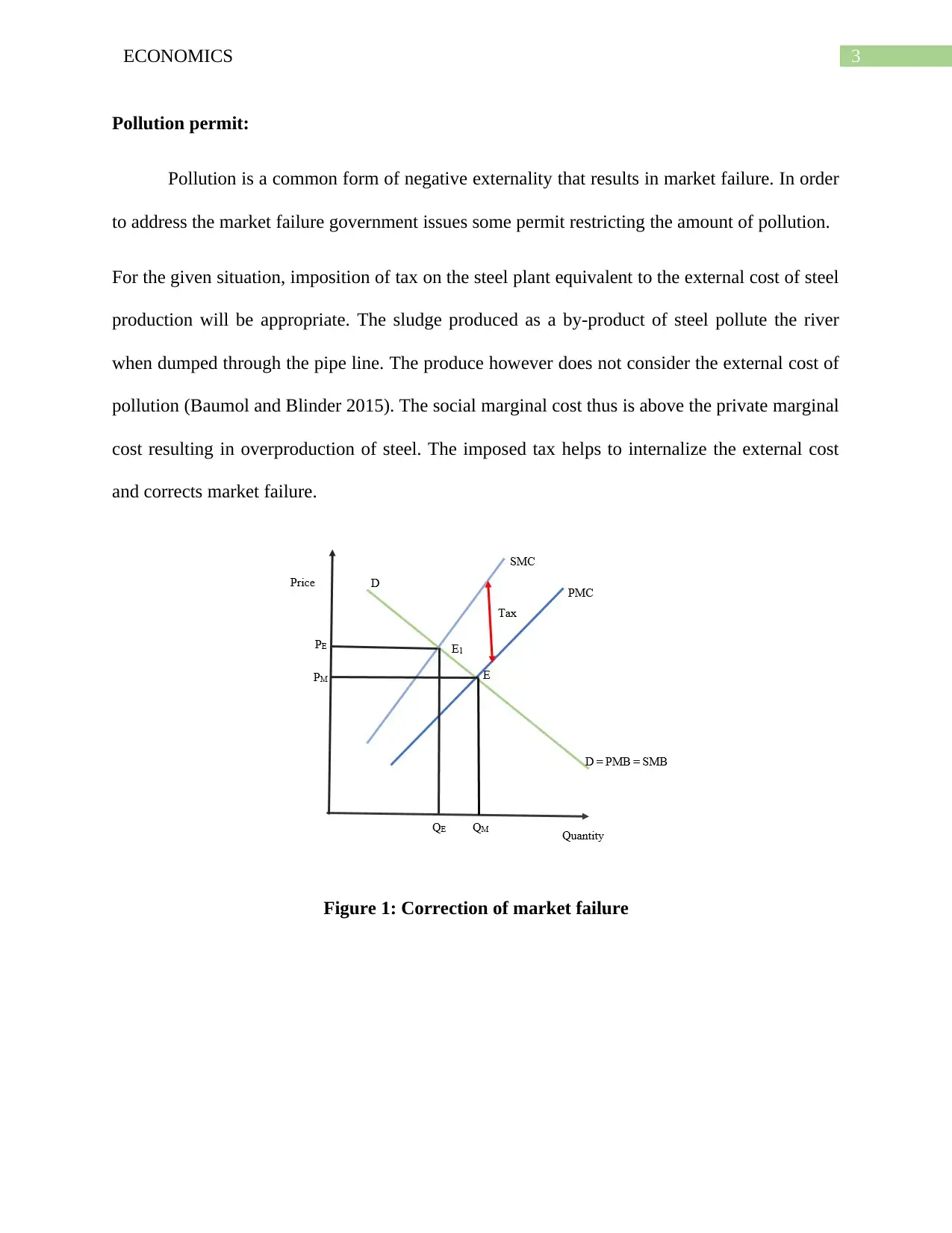
3ECONOMICS
Pollution permit:
Pollution is a common form of negative externality that results in market failure. In order
to address the market failure government issues some permit restricting the amount of pollution.
For the given situation, imposition of tax on the steel plant equivalent to the external cost of steel
production will be appropriate. The sludge produced as a by-product of steel pollute the river
when dumped through the pipe line. The produce however does not consider the external cost of
pollution (Baumol and Blinder 2015). The social marginal cost thus is above the private marginal
cost resulting in overproduction of steel. The imposed tax helps to internalize the external cost
and corrects market failure.
Figure 1: Correction of market failure
Pollution permit:
Pollution is a common form of negative externality that results in market failure. In order
to address the market failure government issues some permit restricting the amount of pollution.
For the given situation, imposition of tax on the steel plant equivalent to the external cost of steel
production will be appropriate. The sludge produced as a by-product of steel pollute the river
when dumped through the pipe line. The produce however does not consider the external cost of
pollution (Baumol and Blinder 2015). The social marginal cost thus is above the private marginal
cost resulting in overproduction of steel. The imposed tax helps to internalize the external cost
and corrects market failure.
Figure 1: Correction of market failure
Paraphrase This Document
Need a fresh take? Get an instant paraphrase of this document with our AI Paraphraser
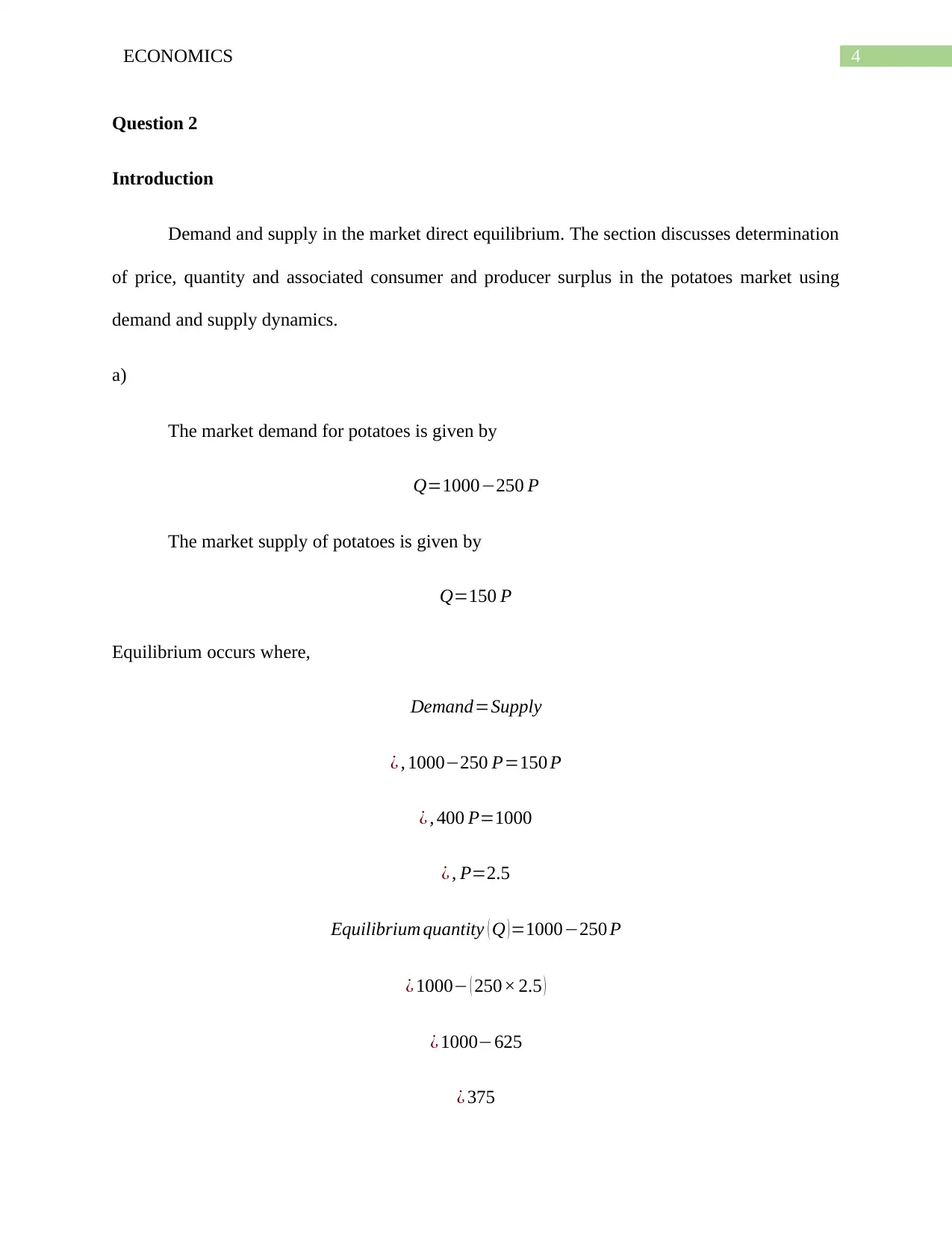
4ECONOMICS
Question 2
Introduction
Demand and supply in the market direct equilibrium. The section discusses determination
of price, quantity and associated consumer and producer surplus in the potatoes market using
demand and supply dynamics.
a)
The market demand for potatoes is given by
Q=1000−250 P
The market supply of potatoes is given by
Q=150 P
Equilibrium occurs where,
Demand=Supply
¿ , 1000−250 P=150 P
¿ , 400 P=1000
¿ , P=2.5
Equilibrium quantity ( Q )=1000−250 P
¿ 1000− ( 250× 2.5 )
¿ 1000−625
¿ 375
Question 2
Introduction
Demand and supply in the market direct equilibrium. The section discusses determination
of price, quantity and associated consumer and producer surplus in the potatoes market using
demand and supply dynamics.
a)
The market demand for potatoes is given by
Q=1000−250 P
The market supply of potatoes is given by
Q=150 P
Equilibrium occurs where,
Demand=Supply
¿ , 1000−250 P=150 P
¿ , 400 P=1000
¿ , P=2.5
Equilibrium quantity ( Q )=1000−250 P
¿ 1000− ( 250× 2.5 )
¿ 1000−625
¿ 375
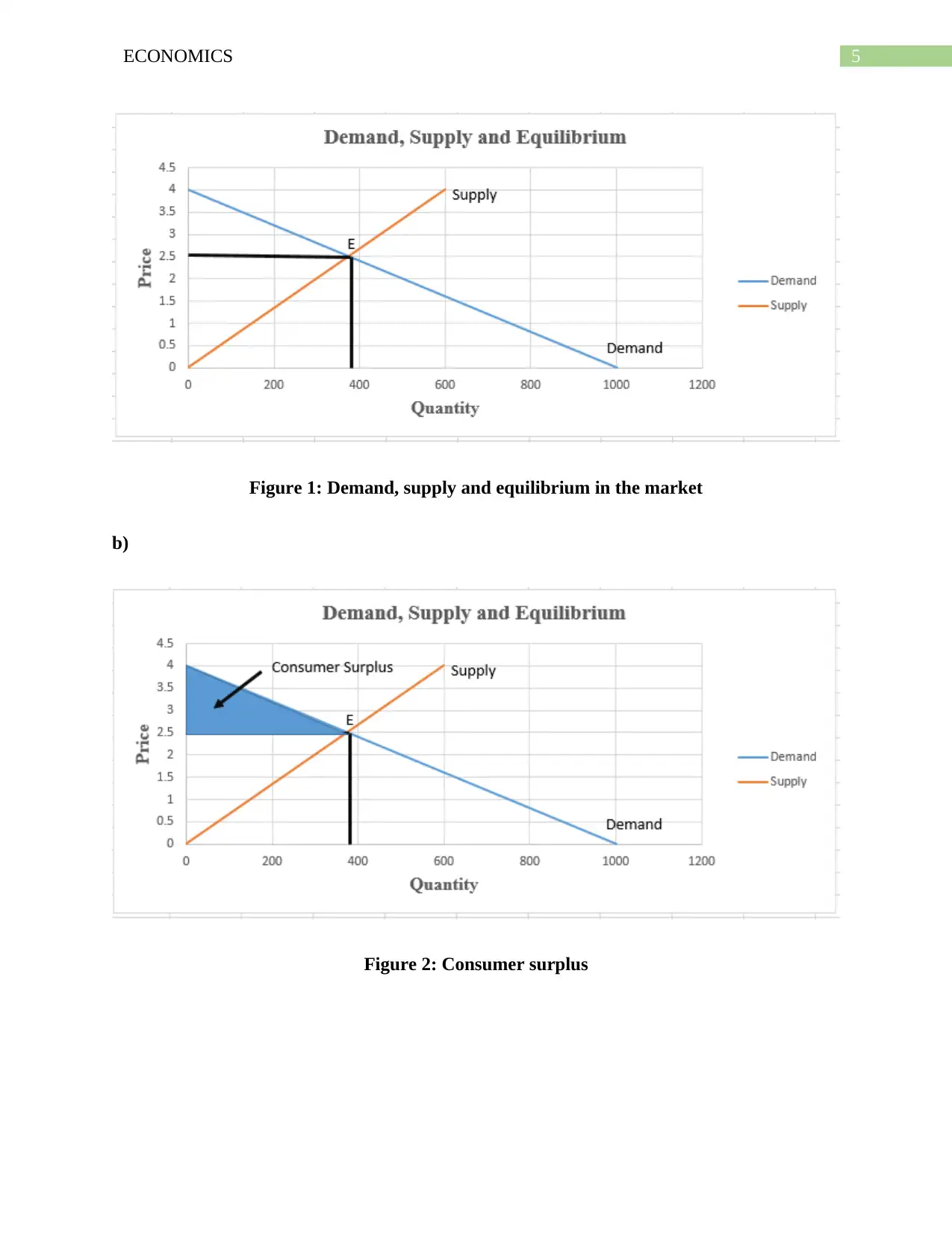
5ECONOMICS
Figure 1: Demand, supply and equilibrium in the market
b)
Figure 2: Consumer surplus
Figure 1: Demand, supply and equilibrium in the market
b)
Figure 2: Consumer surplus
⊘ This is a preview!⊘
Do you want full access?
Subscribe today to unlock all pages.

Trusted by 1+ million students worldwide
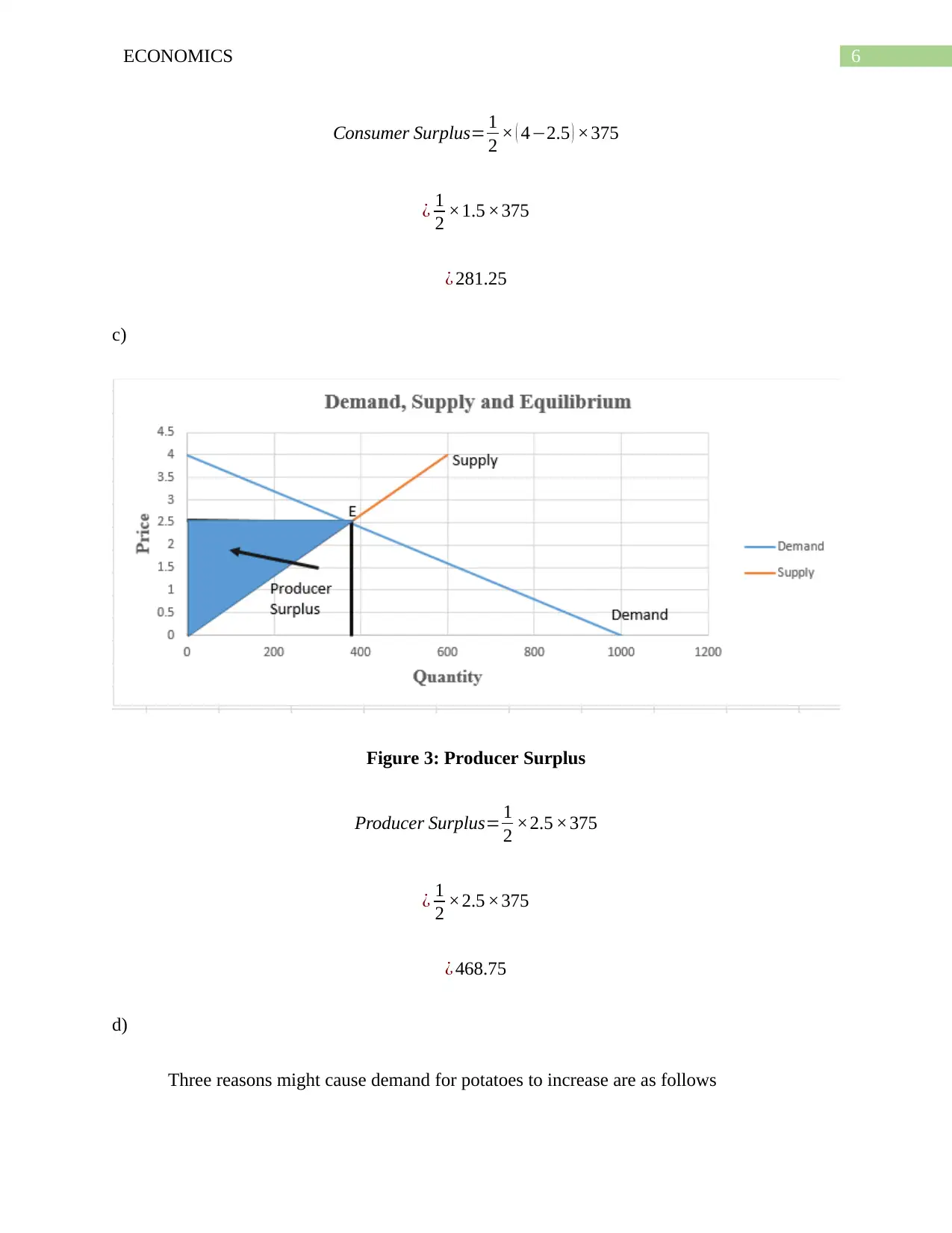
6ECONOMICS
Consumer Surplus= 1
2 × ( 4−2.5 ) ×375
¿ 1
2 ×1.5 ×375
¿ 281.25
c)
Figure 3: Producer Surplus
Producer Surplus= 1
2 ×2.5 ×375
¿ 1
2 ×2.5 ×375
¿ 468.75
d)
Three reasons might cause demand for potatoes to increase are as follows
Consumer Surplus= 1
2 × ( 4−2.5 ) ×375
¿ 1
2 ×1.5 ×375
¿ 281.25
c)
Figure 3: Producer Surplus
Producer Surplus= 1
2 ×2.5 ×375
¿ 1
2 ×2.5 ×375
¿ 468.75
d)
Three reasons might cause demand for potatoes to increase are as follows
Paraphrase This Document
Need a fresh take? Get an instant paraphrase of this document with our AI Paraphraser
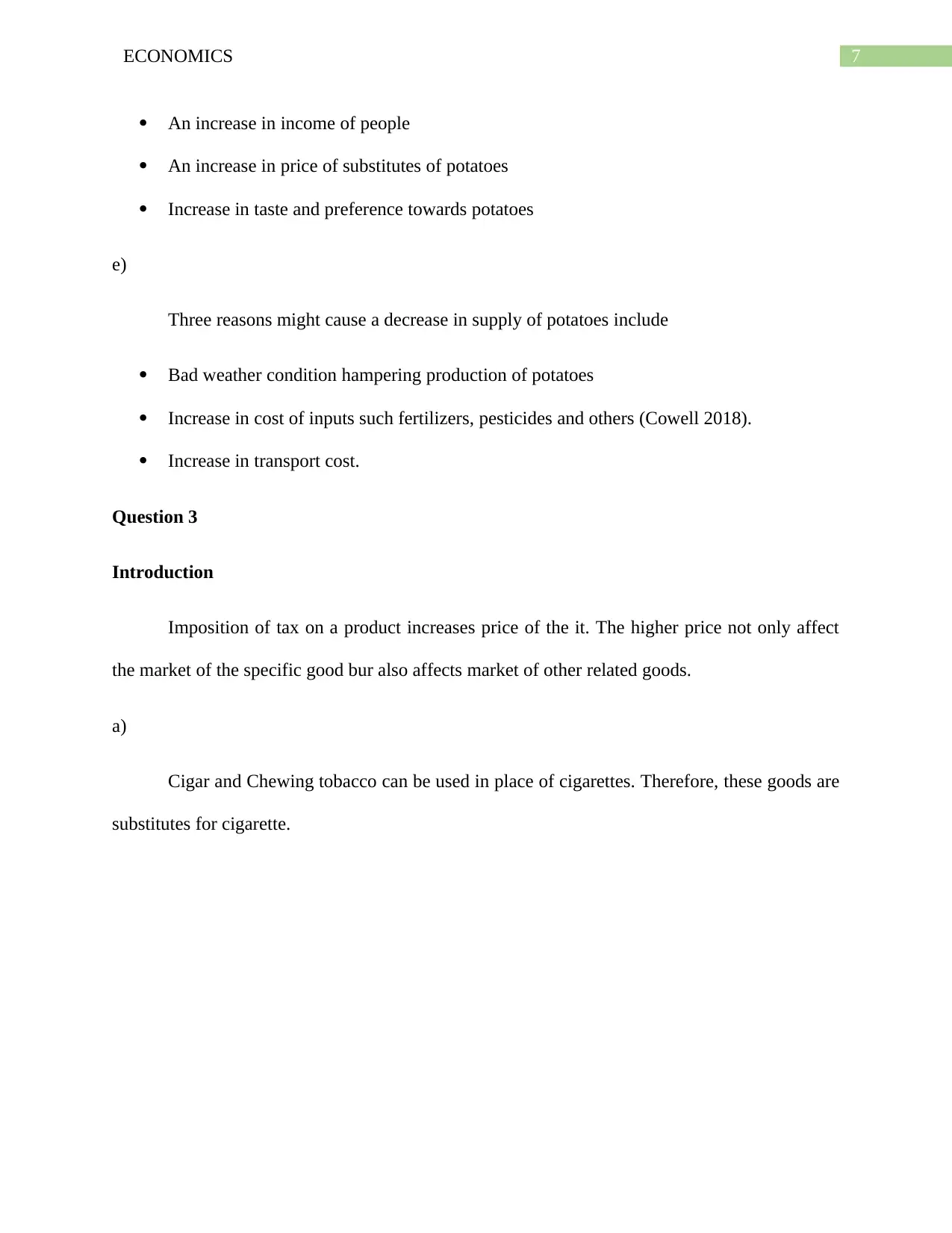
7ECONOMICS
An increase in income of people
An increase in price of substitutes of potatoes
Increase in taste and preference towards potatoes
e)
Three reasons might cause a decrease in supply of potatoes include
Bad weather condition hampering production of potatoes
Increase in cost of inputs such fertilizers, pesticides and others (Cowell 2018).
Increase in transport cost.
Question 3
Introduction
Imposition of tax on a product increases price of the it. The higher price not only affect
the market of the specific good bur also affects market of other related goods.
a)
Cigar and Chewing tobacco can be used in place of cigarettes. Therefore, these goods are
substitutes for cigarette.
An increase in income of people
An increase in price of substitutes of potatoes
Increase in taste and preference towards potatoes
e)
Three reasons might cause a decrease in supply of potatoes include
Bad weather condition hampering production of potatoes
Increase in cost of inputs such fertilizers, pesticides and others (Cowell 2018).
Increase in transport cost.
Question 3
Introduction
Imposition of tax on a product increases price of the it. The higher price not only affect
the market of the specific good bur also affects market of other related goods.
a)
Cigar and Chewing tobacco can be used in place of cigarettes. Therefore, these goods are
substitutes for cigarette.
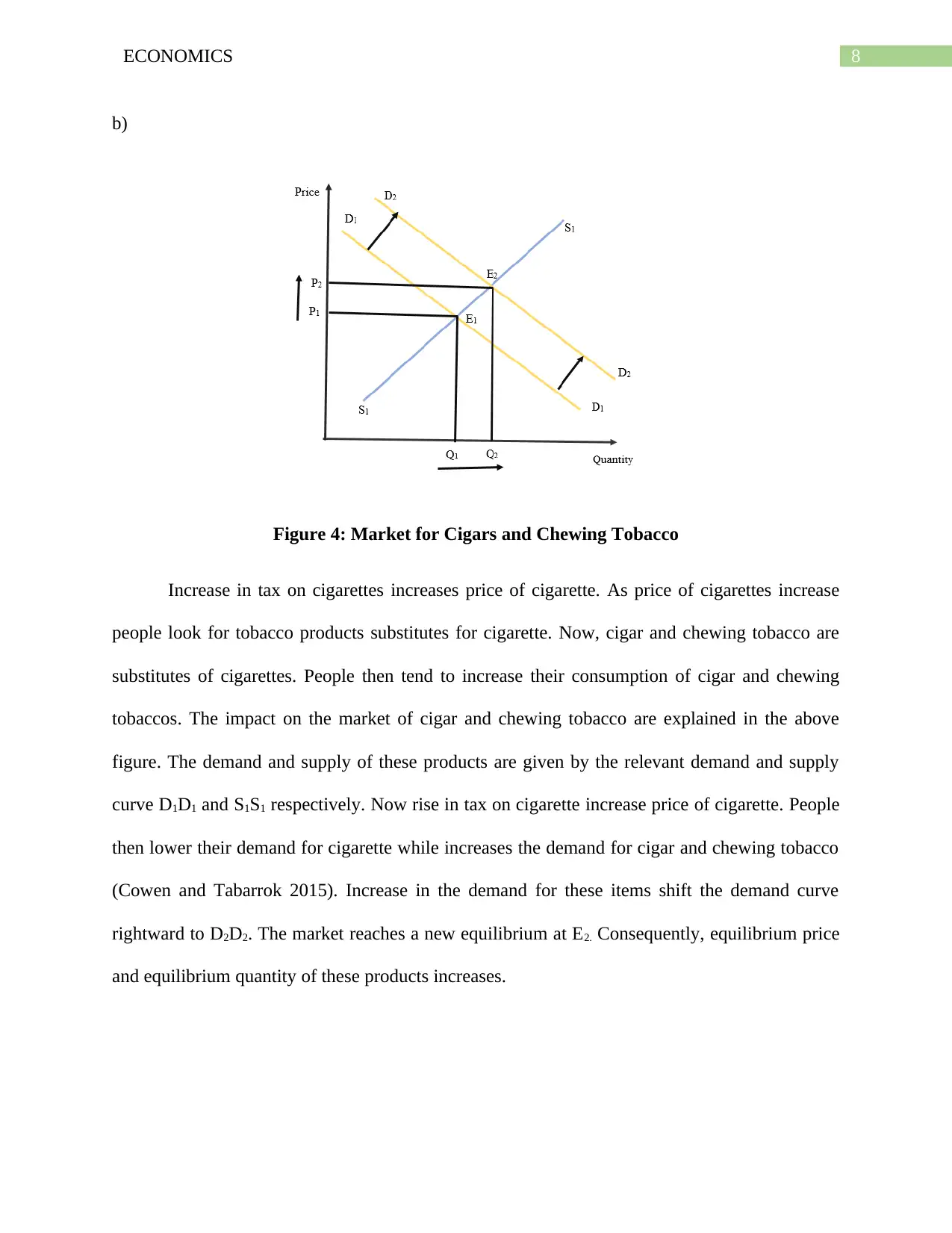
8ECONOMICS
b)
Figure 4: Market for Cigars and Chewing Tobacco
Increase in tax on cigarettes increases price of cigarette. As price of cigarettes increase
people look for tobacco products substitutes for cigarette. Now, cigar and chewing tobacco are
substitutes of cigarettes. People then tend to increase their consumption of cigar and chewing
tobaccos. The impact on the market of cigar and chewing tobacco are explained in the above
figure. The demand and supply of these products are given by the relevant demand and supply
curve D1D1 and S1S1 respectively. Now rise in tax on cigarette increase price of cigarette. People
then lower their demand for cigarette while increases the demand for cigar and chewing tobacco
(Cowen and Tabarrok 2015). Increase in the demand for these items shift the demand curve
rightward to D2D2. The market reaches a new equilibrium at E2. Consequently, equilibrium price
and equilibrium quantity of these products increases.
b)
Figure 4: Market for Cigars and Chewing Tobacco
Increase in tax on cigarettes increases price of cigarette. As price of cigarettes increase
people look for tobacco products substitutes for cigarette. Now, cigar and chewing tobacco are
substitutes of cigarettes. People then tend to increase their consumption of cigar and chewing
tobaccos. The impact on the market of cigar and chewing tobacco are explained in the above
figure. The demand and supply of these products are given by the relevant demand and supply
curve D1D1 and S1S1 respectively. Now rise in tax on cigarette increase price of cigarette. People
then lower their demand for cigarette while increases the demand for cigar and chewing tobacco
(Cowen and Tabarrok 2015). Increase in the demand for these items shift the demand curve
rightward to D2D2. The market reaches a new equilibrium at E2. Consequently, equilibrium price
and equilibrium quantity of these products increases.
⊘ This is a preview!⊘
Do you want full access?
Subscribe today to unlock all pages.

Trusted by 1+ million students worldwide
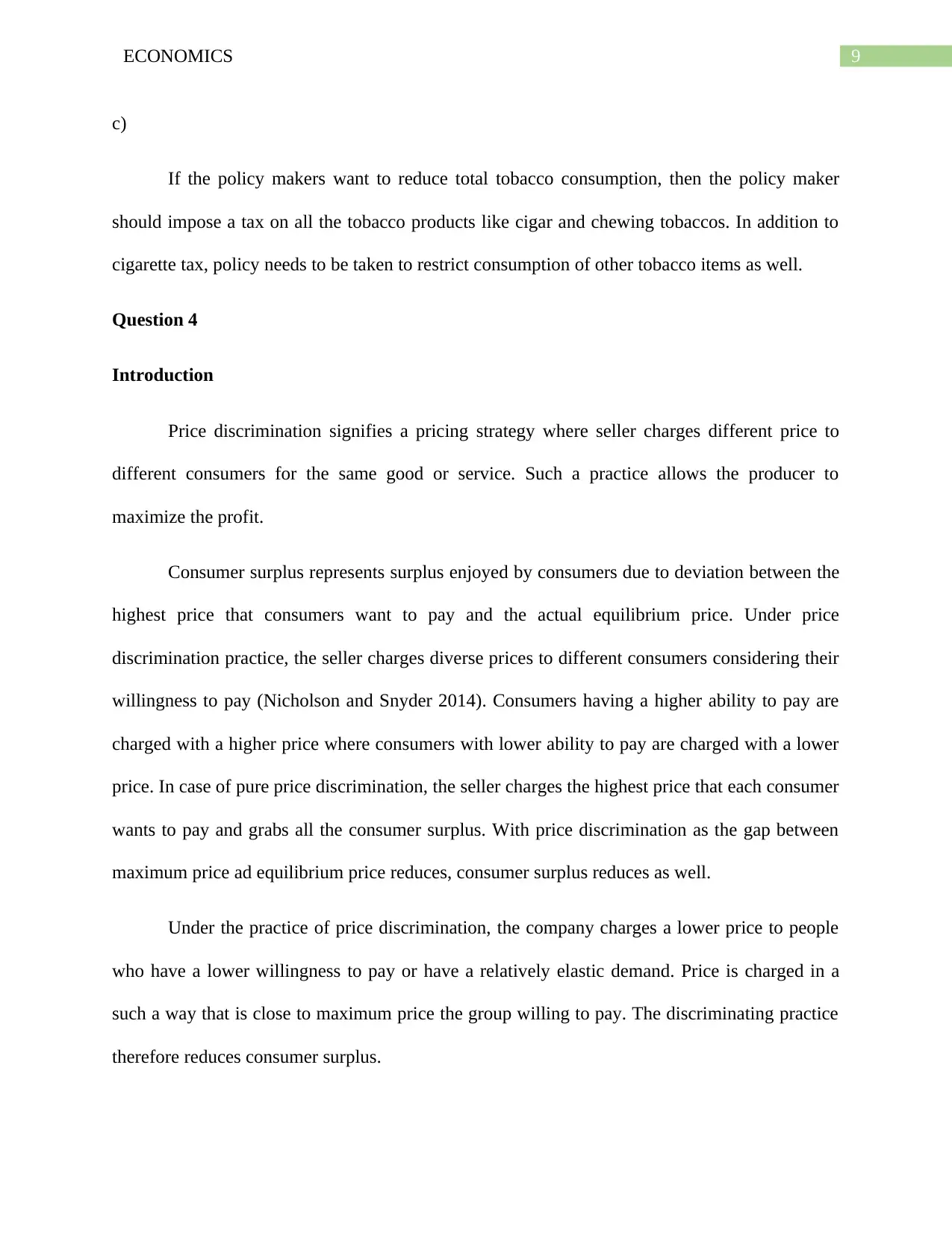
9ECONOMICS
c)
If the policy makers want to reduce total tobacco consumption, then the policy maker
should impose a tax on all the tobacco products like cigar and chewing tobaccos. In addition to
cigarette tax, policy needs to be taken to restrict consumption of other tobacco items as well.
Question 4
Introduction
Price discrimination signifies a pricing strategy where seller charges different price to
different consumers for the same good or service. Such a practice allows the producer to
maximize the profit.
Consumer surplus represents surplus enjoyed by consumers due to deviation between the
highest price that consumers want to pay and the actual equilibrium price. Under price
discrimination practice, the seller charges diverse prices to different consumers considering their
willingness to pay (Nicholson and Snyder 2014). Consumers having a higher ability to pay are
charged with a higher price where consumers with lower ability to pay are charged with a lower
price. In case of pure price discrimination, the seller charges the highest price that each consumer
wants to pay and grabs all the consumer surplus. With price discrimination as the gap between
maximum price ad equilibrium price reduces, consumer surplus reduces as well.
Under the practice of price discrimination, the company charges a lower price to people
who have a lower willingness to pay or have a relatively elastic demand. Price is charged in a
such a way that is close to maximum price the group willing to pay. The discriminating practice
therefore reduces consumer surplus.
c)
If the policy makers want to reduce total tobacco consumption, then the policy maker
should impose a tax on all the tobacco products like cigar and chewing tobaccos. In addition to
cigarette tax, policy needs to be taken to restrict consumption of other tobacco items as well.
Question 4
Introduction
Price discrimination signifies a pricing strategy where seller charges different price to
different consumers for the same good or service. Such a practice allows the producer to
maximize the profit.
Consumer surplus represents surplus enjoyed by consumers due to deviation between the
highest price that consumers want to pay and the actual equilibrium price. Under price
discrimination practice, the seller charges diverse prices to different consumers considering their
willingness to pay (Nicholson and Snyder 2014). Consumers having a higher ability to pay are
charged with a higher price where consumers with lower ability to pay are charged with a lower
price. In case of pure price discrimination, the seller charges the highest price that each consumer
wants to pay and grabs all the consumer surplus. With price discrimination as the gap between
maximum price ad equilibrium price reduces, consumer surplus reduces as well.
Under the practice of price discrimination, the company charges a lower price to people
who have a lower willingness to pay or have a relatively elastic demand. Price is charged in a
such a way that is close to maximum price the group willing to pay. The discriminating practice
therefore reduces consumer surplus.
Paraphrase This Document
Need a fresh take? Get an instant paraphrase of this document with our AI Paraphraser
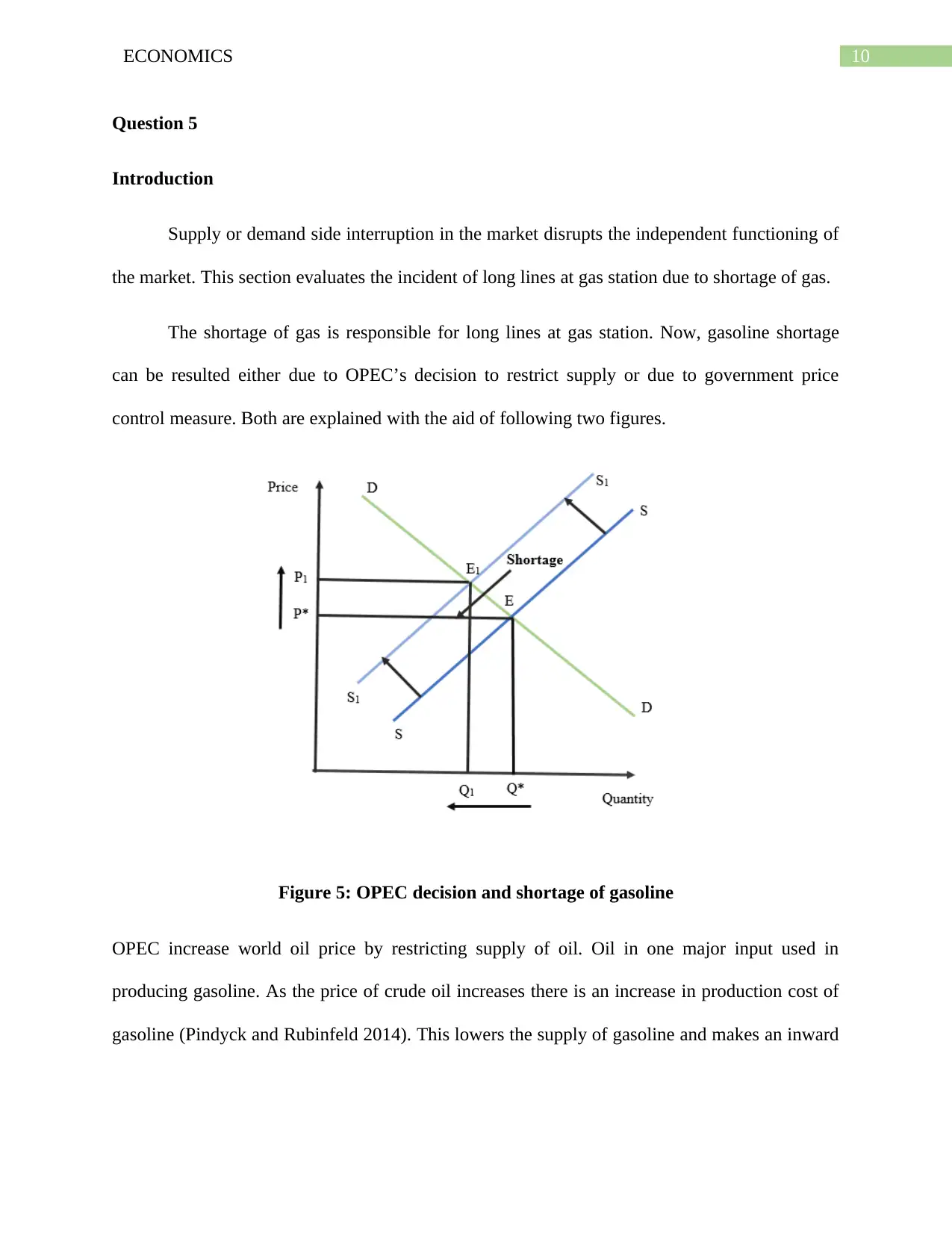
10ECONOMICS
Question 5
Introduction
Supply or demand side interruption in the market disrupts the independent functioning of
the market. This section evaluates the incident of long lines at gas station due to shortage of gas.
The shortage of gas is responsible for long lines at gas station. Now, gasoline shortage
can be resulted either due to OPEC’s decision to restrict supply or due to government price
control measure. Both are explained with the aid of following two figures.
Figure 5: OPEC decision and shortage of gasoline
OPEC increase world oil price by restricting supply of oil. Oil in one major input used in
producing gasoline. As the price of crude oil increases there is an increase in production cost of
gasoline (Pindyck and Rubinfeld 2014). This lowers the supply of gasoline and makes an inward
Question 5
Introduction
Supply or demand side interruption in the market disrupts the independent functioning of
the market. This section evaluates the incident of long lines at gas station due to shortage of gas.
The shortage of gas is responsible for long lines at gas station. Now, gasoline shortage
can be resulted either due to OPEC’s decision to restrict supply or due to government price
control measure. Both are explained with the aid of following two figures.
Figure 5: OPEC decision and shortage of gasoline
OPEC increase world oil price by restricting supply of oil. Oil in one major input used in
producing gasoline. As the price of crude oil increases there is an increase in production cost of
gasoline (Pindyck and Rubinfeld 2014). This lowers the supply of gasoline and makes an inward
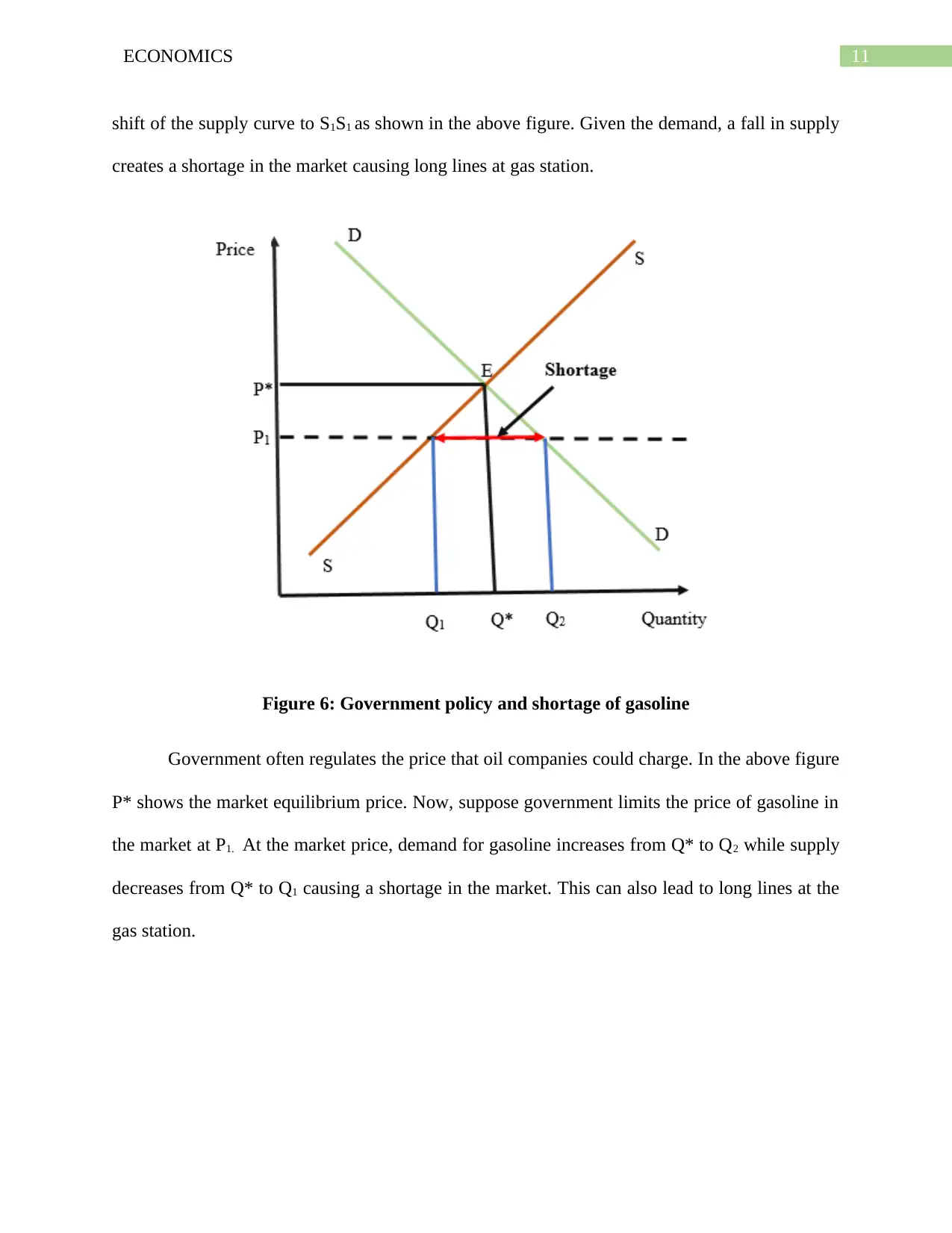
11ECONOMICS
shift of the supply curve to S1S1 as shown in the above figure. Given the demand, a fall in supply
creates a shortage in the market causing long lines at gas station.
Figure 6: Government policy and shortage of gasoline
Government often regulates the price that oil companies could charge. In the above figure
P* shows the market equilibrium price. Now, suppose government limits the price of gasoline in
the market at P1. At the market price, demand for gasoline increases from Q* to Q2 while supply
decreases from Q* to Q1 causing a shortage in the market. This can also lead to long lines at the
gas station.
shift of the supply curve to S1S1 as shown in the above figure. Given the demand, a fall in supply
creates a shortage in the market causing long lines at gas station.
Figure 6: Government policy and shortage of gasoline
Government often regulates the price that oil companies could charge. In the above figure
P* shows the market equilibrium price. Now, suppose government limits the price of gasoline in
the market at P1. At the market price, demand for gasoline increases from Q* to Q2 while supply
decreases from Q* to Q1 causing a shortage in the market. This can also lead to long lines at the
gas station.
⊘ This is a preview!⊘
Do you want full access?
Subscribe today to unlock all pages.

Trusted by 1+ million students worldwide
1 out of 18
Related Documents
Your All-in-One AI-Powered Toolkit for Academic Success.
+13062052269
info@desklib.com
Available 24*7 on WhatsApp / Email
![[object Object]](/_next/static/media/star-bottom.7253800d.svg)
Unlock your academic potential
Copyright © 2020–2025 A2Z Services. All Rights Reserved. Developed and managed by ZUCOL.





